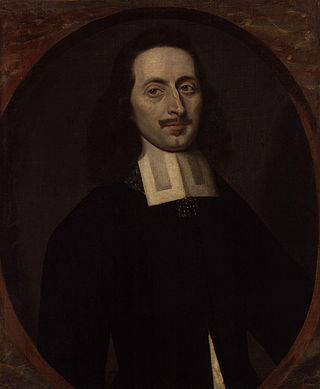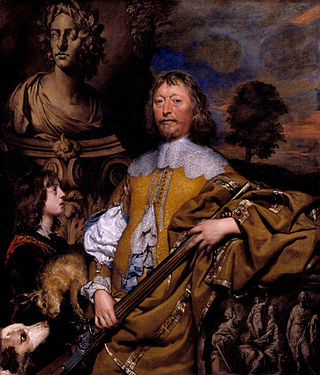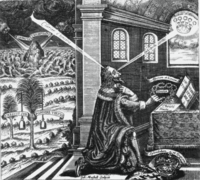
John Earle was an English cleric, author and translator, who was chaplain to Charles II. Towards the end of his life he was Bishop of Worcester and then Salisbury.
This article presents lists of the literary events and publications in 1661.
This article contains information about the literary events and publications of 1649.

The Eikon Basilike, The Pourtraicture of His Sacred Majestie in His Solitudes and Sufferings, is a purported spiritual autobiography attributed to King Charles I of England. It was published on 9 February 1649, ten days after the King was beheaded by Parliament in the aftermath of the English Civil War in 1649.
This is a timeline of events leading up to, culminating in, and resulting from the English Civil Wars.

Endymion Porter (1587–1649) was an English diplomat and royalist.

The Savoy Conference of 1661 was a significant liturgical discussion that took place, after the Restoration of Charles II, in an attempt to effect a reconciliation within the Church of England.

William Marshall was a seventeenth-century British engraver and illustrator, mostly known for his allegorical portrait of King Charles I of England as a Christian martyr, which was published as the frontispiece to the Eikon Basilike.

The Caroline Divines were influential theologians and writers in the Church of England who lived during the reigns of King Charles I and, after the Stuart Restoration, King Charles II. There is no official list of Caroline-era divines; they are defined by the era in which they lived, and Caroline Divines hailed from England, Ireland, Scotland, and Wales. However, of these four nations, it is Caroline England which is most commonly considered to have fostered a golden age of Anglican scholarship and devotional writing, despite the socio-cultural upset of civil war, regicide, and military rule under Oliver Cromwell. Importantly, the term divine is restricted neither to canonised saints nor to Anglican figures, but is used of many writers and thinkers in the wider Christian church.

Brian Duppa was an English bishop, chaplain to the royal family, Royalist and adviser to Charles I of England.
Richard Royston was an English bookseller and publisher, bookseller to Charles I, Charles II and James II.

William Levett, Esq., was a long serving courtier to King Charles I of England. Levett accompanied the King during his flight from Parliamentary forces, including his escape from Hampton Court palace, and eventually to his imprisonment in Carisbrooke Castle on the Isle of Wight, and finally to the scaffold on which he was executed. Following the King's death, Levett wrote a letter claiming that he had witnessed the King writing the so-called Eikon Basilike during his imprisonment, an allegation that produced a flurry of new claims about the disputed manuscript and flamed a growing movement to rehabilitate the image of the executed monarch.

Eikonoklastes is a book by John Milton, published October 1649. In it he provides a justification for the execution of Charles I, which had taken place on 30 January 1649. The book's title is taken from the Greek, and means "Iconoclast" or "breaker of the icon", and refers to Eikon Basilike, a Royalist propaganda work. The translation of Eikon Basilike is "icon of the King"; it was published immediately after the execution. Milton's book is therefore usually seen as Parliamentarian propaganda, explicitly designed to counter the Royalist arguments.
Politics were an important part of John Milton's life. Milton enjoyed little wide-scale early success, either in prose or poetry, until the production of his later, controversial political works starting with The Tenure of Kings and Magistrates and Eikonoklastes.
William Dugard, or Du Gard, was an English schoolmaster and printer. During the English Interregnum, he printed many important documents and propaganda, first in support of Charles I and later of Oliver Cromwell. He also proved a successful master at a number of schools, including the Merchant Taylor's School, Colchester Royal Grammar School and Stamford School, and wrote a number of non-fiction works.

John Warner was an English churchman, Bishop of Rochester and royalist.

William Nicholson was an English clergyman, a member of the Westminster Assembly and Bishop of Gloucester.
John Wilson was an English composer, lutenist and teacher. Born in Faversham, Kent, he moved to London by 1614, where he succeeded Robert Johnson as principal composer for the King's Men, and entered the King's Musick in 1635 as a lutenist. He received the degree of D.Mus from Oxford in 1644, and he was Heather Professor of Music there from 1656 to 1661. Following the Restoration, he joined the Chapel Royal in 1662. He died at Westminster.

Peter Barwick (1619–1705) was an English physician and author.

The Reliquiae Sacrae Carolinae, or The Works of That Great Monarch and Glorious Martyr King Charls the I, is a book that deals with the events leading to the execution of Charles I of England. Originally published in 1650, it is a collective work of the civil and sacred writings on the King. It incorporates the Eikon Basilike as well as speeches and letters by the King during the rise of Oliver Cromwell and the Parliamentarians. It is sometimes referred to as "The King's Works".















